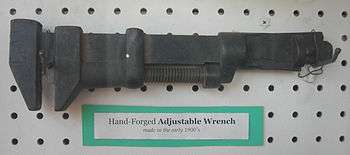Adjustable spanner


2. Adjustable wrench from 1910 with an improved handle (BAHCO)
3. Adjustable wrench from 1914 with a slightly rounder handle (BAHCO)
4. Adjustable wrench from 1954 with improved handle and new jaw angle of 15 degrees (BAHCO)
5. Adjustable wrench from 1984 and the first with ERGO handle (BAHCO)
6. Today's version of the adjustable wrench from 1992 with ERGO (BAHCO)
An adjustable wrench (US) or adjustable spanner (UK) is a wrench with a "jaw" of adjustable width, allowing it to be used with different sizes of fastener head (nut, bolt, etc.) rather than just one fastener, as with a conventional fixed spanner. An adjustable spanner may also be called a Bahco (European usage, see below), crescent wrench (US, Canada and New Zealand usage - see Famous brands section), adjustable end wrench (US), wrench, shifter, shifting spanner (UK, Australia, South Africa), shifting adjustable, fit-all or adjustable angle-head wrench.
Forms and names
In many European as well as Middle Eastern countries (e.g. France, Germany, Portugal, Spain, Italy, Syria, Lebanon, Turkey, etc.) the adjustable wrench is called an "English key" as it was first invented in 1842 by the English engineer Richard Clyburn. Another English engineer, Edwin Beard Budding, is also credited with the invention. Improvements followed: on 22 September 1885 Enoch Harris received US patent 326868[1] for his spanner that permitted both the jaw width and the angle of the handles to be adjusted and locked. Other countries, like Denmark, Poland and Israel, refer to it as a "Swedish key" as its invention has been attributed to the Swedish inventor Johan Petter Johansson, who in 1891 received a patent for an improved design of the adjustable spanner that is still used today. Johansson's spanner was a further development of Clyburn's original "screw spanner". In some countries (e.g. Czech Republic, Egypt, Greece, Hungary, Serbia, Iran, Slovakia, Slovenia, Poland, Romania, Bulgaria) it is called "French key" (in Poland, "Swedish" or "French" key depending on type). In the USA, the tool is known as a Crescent wrench or an adjustable wrench.
There are many forms of adjustable spanners, from the taper locking spanners which needed a hammer to set the movable jaw to the size of the nut, to the modern screw adjusted spanner. Some adjustable spanners automatically adjust to the size of the nut. Simpler models use a serrated edge to lock the movable jaw to size, while more sophisticated versions are digital types that use sheets or feelers to set the size.
The fixed jaw can withstand bending stress far better than can the movable jaw, because the latter is supported only by the flat surfaces on either side of the guide slot, not the full thickness of the tool. The tool is therefore usually angled so that the movable jaw's area of contact is closer to the body of the tool, which means less bending stress.
Monkey wrenches are another type of adjustable spanner with a long history; the origin of the name is unclear.[2]
The type of straight adjustable spanner with jaws at right angles to the handle shown here as an "English Key" is mainly called a "King Dick" spanner in the United Kingdom because of a popular British brand of small, handy and reliable adjustable spanner used throughout the 1900s and used in great numbers during World War 2.
-

A French key
-

An English key
-

The "keyway" of an adjustable wrench
-

Chrome vanadium adjustable wrench
Proper use
The movable jaw should be snugly adjusted to the nut or bolt head in order to prevent damage to the fastener's head, or rounding. This type of spanner should not be used on a rounded off nut, as this can overload the movable jaw. Nor should such a wrench be used "end on" in cramped quarters (except perhaps when the nut is barely more than finger-tight), where a socket wrench is more appropriate.
Some cheaper brands' jaws move when twisting on tight nuts.
Famous brands
In the United States and Canada, the adjustable spanner (adjustable wrench) is colloquially referred to as a "crescent wrench" due to the widespread Crescent brand of adjustable wrenches. The Crescent brand of hand tools is owned and marketed by Apex Tool Group, LLC. In some parts of Europe, adjustable spanners are often called a Bahco.[3] This term refers to the company of the Swedish inventor Johan Petter Johansson, which was originally called B.A. (Bernt August) Hjort & Company. The Swedes themselves call the key "skiftnyckel" which is translated into adjustable key (shifting key).
See also
- Pipe wrench or Stillson wrench
- Plumber wrench
- Monkey wrench
- Channellock
- Diamond Calk Horseshoe Company
References
| Wikimedia Commons has media related to Adjustable wrenches. |
| ||||||||||||||